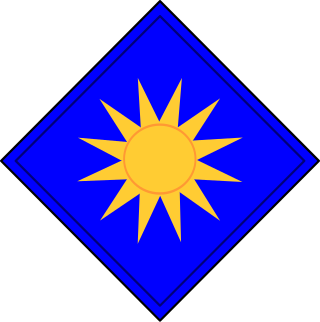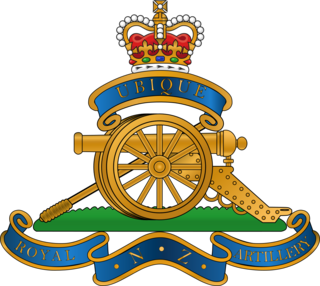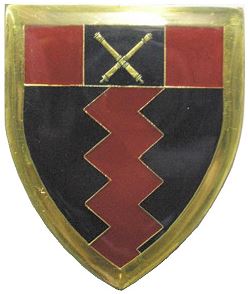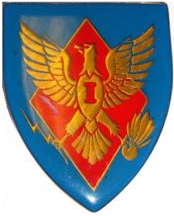
A battalion is a military unit, typically consisting of up to one thousand soldiers commanded by a lieutenant colonel and subdivided into a number of companies, each typically commanded by a major or a captain. The typical battalion is built from three operational companies, one weapons company and one headquarters company. In some countries, battalions are exclusively infantry, while in others battalions are unit-level organisations.

The 36th Infantry Division ("Arrowhead") also known as the "Panther Division", the "Lone Star Division", "The Texas Army", and the "T-patchers", is an infantry division of the U.S. Army and part of the Texas Army National Guard. The 36th Infantry Division was organized during World War I (1914–1918) from units of the Texas National Guard and of the Oklahoma National Guard. As an all-Texas unit, the Arrowhead Division was called to service for World War II (1937–1945) on 25 November 1940, was deployed to the European Theater of Operations in April 1943, and returned to the Texas Army National Guard in December 1945.

The 40th Infantry Division is a modular division of the United States Army. Following the army's modularization the division has become a four-brigade combat team with National Guardsmen from throughout the Pacific/Western United States and Oceania. Its division headquarters is located at Los Alamitos Joint Forces Training Base in Los Alamitos, California.

The Royal Regiment of New Zealand Artillery is the artillery regiment of the New Zealand Army. It is effectively a military administrative corps, and can comprise multiple component regiments. This nomenclature stems from its heritage as an offshoot of the British Army's Royal Artillery. In its current form it was founded in 1947 with the amalgamation of the regular and volunteer corps of artillery in New Zealand. In 1958 in recognition of services rendered it was given the title the Royal Regiment of New Zealand Artillery.
The 4th Regiment, Royal Australian Artillery is an artillery unit of the Australian Army. Currently it provides close artillery support to the 3rd Brigade and is based at Chau Pha Lines, Lavarack Barracks in Townsville, Queensland. The regiment was raised in its current form in 1960 and is currently re-equipping with M777A2 lightweight towed howitzers. The regiment deployed during Australia's commitment to the Vietnam War and has subsequently deployed to Singapore and East Timor.

The Georgia Army National Guard is the Army National Guard component of the Georgia National Guard, administratively part of the Georgia Department of Defense. It consists of more than 11,100 citizen-soldiers training in more than 79 hometown armories and regional facilities across the state. Georgia’s Army Guard is the sixth largest in the nation and includes combat, combat support and combat service support units.

The 82nd Division was formed under British control during the Second World War. It took part in the later stages of the Burma Campaign and was disbanded in Burma between May and September 1946.
1st Regiment Royal Horse Artillery is a regiment of the Royal Horse Artillery in the British Army. It currently serves in the armoured field artillery role, and is equipped with the AS90 self-propelled gun. The regiment is currently based at Larkhill Garrison, Larkhill. The regiment completed its move from Assaye Barracks, Tidworth, to Larkhill in June 2019.

The 46th Infantry Division was a formation of the Michigan Army National Guard active between 1947 and 1968. It was initially headquartered at Lansing. Many of its units had previously been part of the 32nd Infantry Division. It was converted to the Reorganization Objective Army Division (ROAD) structure in March 1963. The Division's 2nd Brigade was assigned to the Selected Reserve Force, a higher-readiness component of the ARNG, in 1965. Virtually the entire division was involved in responding to the 12th Street riot in Detroit in July–August 1967.
M (Headquarters) Battery Royal Horse Artillery is the Headquarters Battery of 3rd Regiment Royal Horse Artillery, part of the Royal Horse Artillery of the British Army. As of 2015, it is based at Albemarle Barracks, Northumberland, England. The Battery Commander is Maj B Johnston RHA.

Radar, Field Artillery, No 15, better known as Cymbeline, was a widely used British mortar locating radar operating in the I band using a Foster scanner. Developed by Thorn-EMI and built at their now-defunct site at Hayes in Middlesex, it was in British service from 1975 until about 2003 with the Royal Artillery.
During the Second World War the British Army deployed armoured divisions and independent armoured and tank brigades.

The Steve Biko Artillery Regiment is a airborne artillery regiment of the South African Artillery.

7 Light Anti-Aircraft Regiment is a reserve force regiment of the South African Army Air Defence Artillery Formation.
I Parachute Battery Royal Horse Artillery is the Headquarters battery of 7th Parachute Regiment Royal Horse Artillery, part of the Royal Horse Artillery of the British Army, currently based in Albemarle Barracks in Newcastle Upon Tyne.
T Battery Royal Artillery is an air defence battery of the Royal Artillery that serves with the British Army's 12 Regiment Royal Artillery. It is stationed at Baker Barracks, Thorney Island, West Sussex.

10 Artillery Brigade was a South African Defence Force formation designed for mass artillery barrages, mainly for the 7 South African Infantry Division or 8 South African Armoured Division, as well as an ad hoc formation during Operation Prone, when needed and detached and reattached where required. Smaller components would then be used at the battlegroup level.

14 Artillery Regiment was a South African Artillery unit whose name was used twice. It was re-established in Potchefstroom in 1974 and was a full-time unit responsible for the training of Permanent Force and National Service personnel.

2 Locating Regiment was an artillery regiment of the South African Artillery. The regiment provided divisional troops but was typically organized to allocate locating batteries to brigades.

The 100th (Yeomanry) Regiment, Royal Artillery, formerly the National Reserve Headquarters, Royal Artillery is an Army Reserve administrative group of the Royal Artillery which oversees the recruitment and maintaining of specialist reserve units and personnel.















